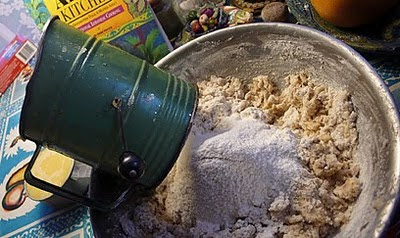hearty is an understatement! shourbat makhlouta—the name of this hardy, protein-rich soup comes from the arabic word for "mixed up" or "mixture" since it is made by "shopping" in your kitchen pantry for a little bit of every grain, legume, and bean that you have. because i am an avid cook, as was my beloved mother, alice, like hers my pantry is full as a commercial pantry with many varieties of beans, grains, and legumes to enrich the soup. my sweet lebanese friend josephine tells me her mother used lamb to fortify the soup, while my dear mom's was strictly vegetarian, so of course mine is too.
in this easy-to-make lebanese soup recipe, it takes about a cup and a half of dried beans, grains, and legumes to about 7 cups of water, a couple of chopped onions, a generous amount of olive oil, salt, pepper, and cayenne pepper all put into the pot, brought to a boil, and then simmered until everything is tender—about 1 1/2 to 3 hours. ladle into bowls with a drizzle of lemon juice to finish off with some pita chips on the side. from the recipe on page 54 in alice's kitchen: traditional lebanese cooking.

you can see in the detail photo how thick the soup has become because of the addition of red lentils, which cook and thicken quickly. the other ingredients in this particular batch starting with the large bean in the foreground are a tablespoon each of: scarlet runner beans from the garden, pintos, adzukis, small favas, white, cranberry (borlotti) beans also saved from the garden's summer crop that hid until they were too tough for fresh green beans, black beans, red and green lentils, garbanzos, split peas, kidney and red beans, black-eyed peas, yellow peas, whole wheat berries, barley, brown rice, and on the right you can see a corn kernel, also from summer garden that was too starchy for fresh eating, so i left the kernels on the cob to dry in the pantry, and just plucked them off the cob and into the pot for the soup. somehow even with the disparate sizes of ingredients, it all cooks to a wonderful nourishing tenderness.
my dear friend samar from lebanon tells me that this soup is traditionally made at the end of winter to clean out the pantry from the last year's stores, and this is just what my makhlouta turned out to be. in going through my pantry, i found some large fava beans from several years back tucked away in a corner. there were holes in the beans and some round black dry questionable looking bits suspiciously the same size and shape as the holes. these did not go into the soup!
but my curiousity as a gardener prevailed and i added water to the jar of beans and soaked them overnight. this is my usual method to determine seed viability before i plant beans, corn, and other vegetable seeds. this method also gives the seeds a head-start on slugs and birds, and others hungering after my tempting plump spring seeds.
after soaking, i rinse twice a day for a couple of days and observe to see if they sprout. (yes, this is how bean and seed sprouts are made!) and if you have been following my blog, by now you understand this is not for the squeamish or faint of heart!
here's what happened:

they sprouted in spite of the bug holes, which you can see! these large favas are also called horse beans, and they are larger than a quarter, and after soaking get even bigger. they are nitrogen-fixing plants and enrich the garden soil, and are a very hardy staple for winter gardens in most mediterranean countries. my parents' Lebanese mountain village of Douma is no exception.
so i planted them, as my new lebanese friend joseph (yusef) who has a new falafel and produce stand in southeast portland (farmer's backyard at s.e. 11th and madison) suggested it's not too late to plant fava beans. in the pacific northwest, they're best planted in the fall for spring harvest. often if i plant them in the spring, the summer flowering plants, whose blossoms have a most lovely fragrance attract black aphids; while the fall-planted seeds produce before the season of the aphids. mid-january must be a mid-winter planting. it will be interesting to see how these fare. so here's my new fava bean bed planted last weekend before covering with soil, with the first sign of spring—a snowdrop—blooming nearby! on a dark grey and misty day, this life-giving activity energizes and gives me hope for the sunny days to come!

after planting it's time to take off the muddy gloves and come inside to enjoy a steaming hot bowl of shourbat makhlouta! sahtein!





























